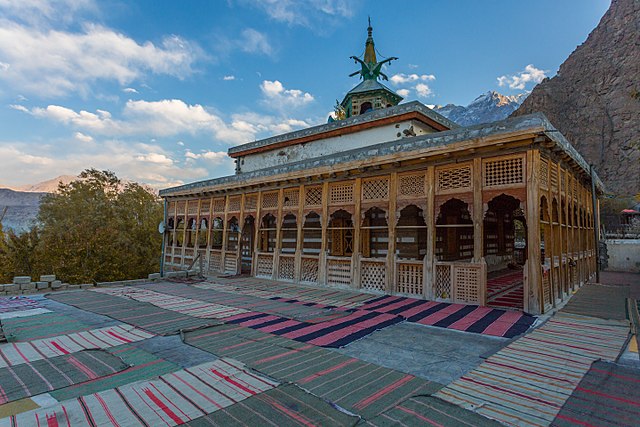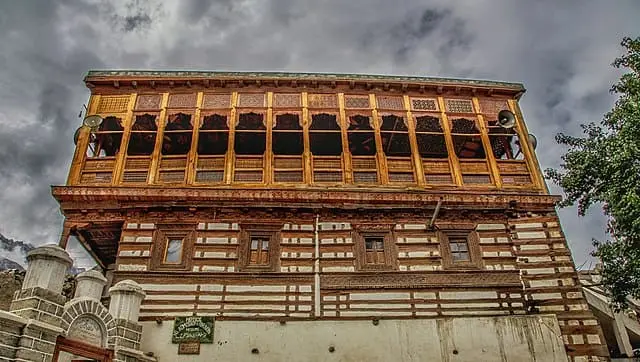Chaqchan Mosque Travel Guide: A Spiritual Stop in Khaplu

Chaqchan Mosque in Khaplu is notable for its age, architectural style, and historical significance related to the region’s conversion from Buddhism to Islam. Dating back to 1370 CE, this incredible mosque is a treasure of Sufi architecture, captivating tourists, researchers, and spiritual seekers alike.
From the moment you arrive, you’ll find that Chaqchan Mosque isn’t just another historic site—it’s a window into the region’s shift from Buddhism to Islam, featuring an enchanting blend of Tibetan, Kashmiri, and Persian styles.
Why Visit Chaqchan Mosque? What You’ll Learn
Historical significance: Learn how local Buddhism faded and Islam took root in the 14th century.
Architectural marvel: Study the unique construction using wood, clay, and mud—Romans called it opus craticum.
Authentic experience: Feel the energy of carved wooden pillars and vibrant jali screens still in use today.
Practical tips: Discover best times to visit, respect guidelines, and how to blend in culturally.
History & Significance of Chaqchan Mosque
 The story of Chaqchan Mosque is the story of religious transformation in Baltistan. Built around 1370 CE, its two origin theories spotlight Sufi saints Mir Sayyid Ali Hamadani and Syed Nurbakhsh, with Hamadani historically more likely due to dating.
The story of Chaqchan Mosque is the story of religious transformation in Baltistan. Built around 1370 CE, its two origin theories spotlight Sufi saints Mir Sayyid Ali Hamadani and Syed Nurbakhsh, with Hamadani historically more likely due to dating.
Local legends say the mosque sprang to life after the Raja of Khaplu embraced Islam, marking a shift from Tibetan Buddhism to Sufi Islam. Its name, “Chaqchan” or “Miraculous Mosque”, reflects the reverence locals feel toward this spiritual gem.
Architecture That Speaks — Literally
Two-Story Wooden Wonder
Built as a two-story cubic structure, it features a semi-basement, ground floor, and top-floor turrets with wraparound verandahs.
Construction uses wooden slab framing unfilled with clay/mud, akin to Roman opus craticum, ideal for extreme mountain climates.
Intricate Carvings & Jali Screens
Every surface is adorned—ceiling to lattice windows—with detailed geometric wood carvings and ornate calligraphy.
The jali (lattice) windows allow soothing light and airflow—perfect for contemplation and prayer.
A Tapestry of Styles
A harmonious blend of Tibetan, Kashmiri/Mughal, and Persian architecture reflects Khaplu’s multicultural crossroads.
The mosque preserves carved motifs and structural designs reminiscent of its Buddhist heritage, visible in exterior patterns.
Visiting Guide To Chaqchan Mosque:
Best Time to Visit
Ideal months: May to September, when the weather is mild and the mountain views are at their best.
Go early morning or late afternoon to avoid crowds.
How to Arrive
Reach Khaplu via Skardu by road (approx. 100 km) or from Kashmir/Ladakh.
The mosque rests on a serene hillside, easy to reach on foot from the town center.
Respectful Visiting
Dress modestly (shoulders and knees covered); remove shoes before entering.
Donations are appreciated—mosque upkeep relies on community support.
Speak softly; photography is allowed, but avoid disrupting worship.
Unique Insight: Embrace the Spiritual Alchemy
Nearly every mosque tour explains the architecture—but here’s what few highlight:
Feel the transformation. As you walk in, you’re tracing the footsteps of pilgrims and Sufi hearts spanning centuries. That carved wood? Each curve and motif is a story—faith etched in history.
Climate-wise design. The clay-and-wood method wasn’t just style—it was survival. Warm in winter, cool in summer; its architecture in dialogue with nature.
Layered beliefs. Buddhist geometric patterns subtly merge with Islamic calligraphy; the mosque itself is living proof of overlapping civilizations.
Challenges & Things to Note ⚠️
High altitude & remote access: Bring warm layers even in summer. Roads can be rough—opt for 4WD transit.
Conservation caution: Some parts are under fragile restoration; avoid leaning or touching delicate carvings.
Cultural awareness: It’s active—avoid visiting during Fajr/Asr without permission.
Step-by-Step Visit Itinerary
Arrive in Khaplu and settle in town.
Walk to the mosque—and enjoy panoramic valley views.
Pause on the veranda; sit quietly and absorb the atmosphere.
Enter the prayer hall, admire the carvings, the mihrab, and quiet spirituality.
Engage locally: speak with caretakers for community insights.
Explore surroundings: nearby Khaplu Palace, Shyok River.
Reflect & share: pen observations; local artisans often love sharing details of the woodwork.
Quick FAQs
Which is the second largest mosque in Pakistan?
The Faisal Mosque in Islamabad holds that title.
What are the top 3 mosques in the world?
Masjid al-Haram (Mecca)
Al-Masjid an-Nabawi (Medina)
Al-Aqsa Mosque (Jerusalem)
Why is the Quba Mosque famous?
It’s Islam’s first mosque, built by the Prophet Muhammad in Medina.
Where is the El Sahaba Mosque?
Near Jabal al-Nour, on the outskirts of Makkah, Saudi Arabia.
How old is the Sahaba Mosque?
Also 7th century—among Islam’s earliest.
Where is Masjid E Jinn?
Located in Mecca, near the Jinn Cave.
Conclusion
Chaqchan Mosque isn’t just an architectural wonder—it’s a living chronicle of faith, culture, and craftsmanship in Gilgit-Baltistan. From its 14th-century origin to its awe-inspiring woodwork, it offers profound insights into religious transformation and sustainable design.
Plan your visit, bring curiosity, and leave with a story you’ll carry forever.
Comment below: Have you experienced Chaqchan Mosque or plan to visit? Share your story—or your questions—and let’s connect!
